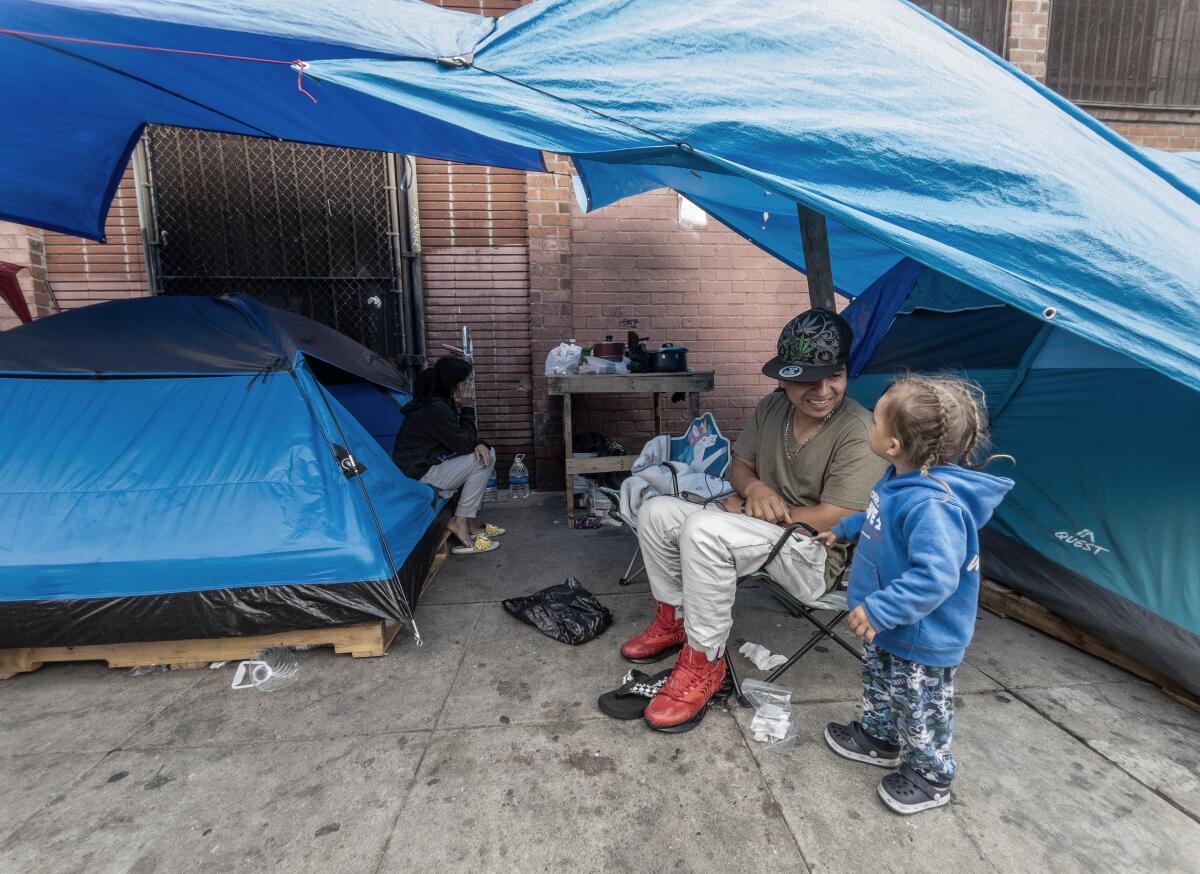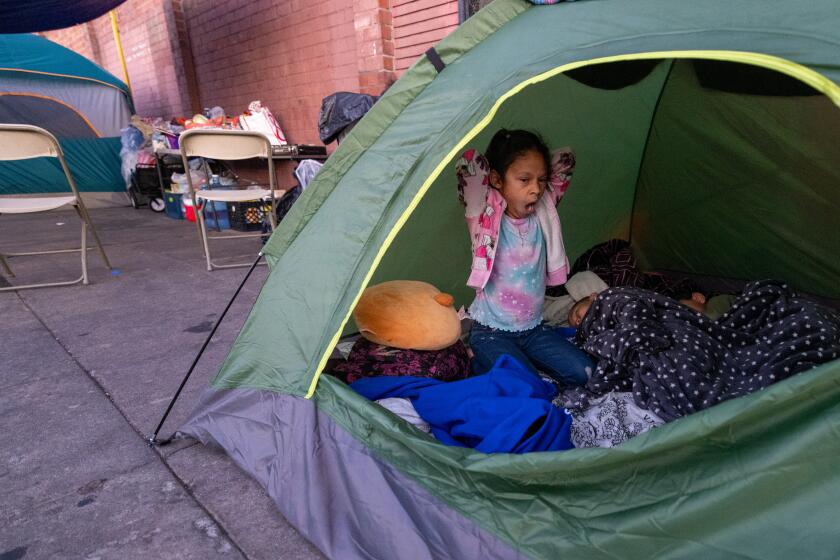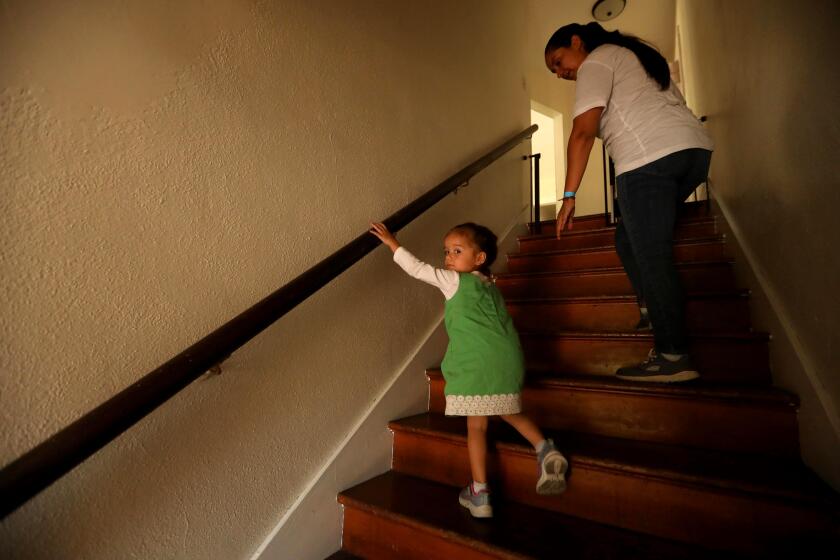As L.A. County sees an increase in homeless families, agencies are struggling to help

On a Friday just before 9 a.m., men, women and children packed the lobby of the Family Solution Center in South Los Angeles. A mother with her two young boys said they had been sleeping in her car for months. She had arrived hoping to secure a spot in a shelter. Another, who sat with three of her children, ages 2, 6 and 8, lived in a shelter and was hoping for help with a deposit on an apartment.
They were among more than two dozen family members who started lining up hours before the center opened at 8:30 a.m., hoping for housing assistance.
“I want to find shelter so I can get back to working,” said Rosibel Marcial, who has been living in her car with her boys.
In recent months, the center, which serves families that are homeless or on the verge of homelessness, has seen increasing numbers of people in need of assistance. And it is struggling to help them.
“It’s pretty dire,” said Veronica Lewis, director of the nonprofit HOPICS, which runs the center. “And it’s very disheartening. Obviously, for them mainly. But for us too, because we’re here to meet their needs.”
Across L.A. County, there has been a 45% increase in the number of families in the homeless system compared to last year, officials say. In the first quarter of the previous fiscal year there were 1,257 families in the system. This year, the first quarter saw 1,817 families, according to the Los Angeles Homeless Services Authority. The increase is stressing a system that was already under intense strain.
In recent months, dozens of families have set up on sidewalks on Skid Row, with babies sleeping in portable cribs and toddlers playing inside tents — a dire sight that had been rare until this year, experts say. Many of those families are recently arrived migrants who are not eligible for the same supports as residents.
Arriving from Texas, the four migrant families from Central and South America, with children as young as 2, spent 90 days in the Union Rescue Mission in Skid Row. Then, told they’d have to pay rent they didn’t have, they formed an impromptu community in a tent encampment two blocks away.
But advocates and officials say local families are also driving the number of homeless families up throughout the region.
“Across the county, families are feeling the squeeze of rising costs and stagnant wages — especially as pandemic-era wage support and eviction protections expire — putting increased pressure on the homeless response system for families,” officials with the county’s Homeless Initiative said in a statement.
Nearly three-quarters of renters and those under 35 have considered moving out of Los Angeles because housing costs are too high, according to a new poll.
The sky high cost of rent is especially challenging for families, advocates said. The county does not have anywhere near the 500,000 units of affordable housing it estimates are needed for low- and very low-income families.
“I think that housing, the cost of housing is probably pushing people out, and then having children just makes it even more difficult,” said Veronica Lepper, associate director of family programs for the nonprofit PATH.
Those costs also make it difficult for families that manage to secure temporary housing subsidies to eventually pay rent on their own. Across the county, there was a 35% decrease in families exiting time-limited subsidy programs, according to LAHSA.
Officials say an increase across the county in applications for welfare through CalWORKs is another indicator that families are struggling. The program, which gives cash aid and services to eligible families, saw a 33% jump in applications from February 2023 to February 2024, officials said. Not all families are eligible for the help, including many migrant families.
The county is also contending with the limits of a system that was created largely to address the housing needs of single adults.
In the immediate term, the county has allocated $10 million in additional funding to help expand interim housing for families, increase housing navigation support and scale up efforts to remove barriers to securing permanent housing units.
But there are big challenges in getting help to families that need it now.
HOPICS, a nonprofit agency that provides services to homeless families, serves an area that includes South L.A., Compton and Lynwood and has long contended with large numbers of homeless families.
“Even with the high numbers that we’ve been accustomed to seeing, we are seeing exponentially higher numbers of families,” said Lewis, the director. “In particular, families that have never experienced homelessness before.”
Since July, about 1,647 families have asked the organization for help with housing. It has only been able to meet the needs of about a quarter of them.
There simply aren’t enough housing options for families in the county, Lewis said. The organization itself provides interim housing to about 300 families.
The group has also seen a significant increase in the number of families on the brink of eviction that arrive seeking help, Lewis said. Increasingly, they owe large amounts of money, often more than $10,000, in back rent.
After the last of L.A.’s COVID-era renter protections expired in February, tenants could be required to pay all back rent accumulated during the pandemic.
Eviction court filings increased by about 2,000 in the first three months of this year, compared with last year — a year that saw more filings than any year since 2016, according to data compiled by Kyle Nelson, senior policy and research analyst for the nonprofit advocacy group Strategic Actions for a Just Economy.
While staffers do their best to offer some kind of support to every family that walks through the doors, covering tens of thousands of dollars in back rent simply isn’t possible for large amounts of people, Lewis said.
When families arrive in need of shelter, it’s often not available, something that weighs on the workers whose job it is to offer help.
“It’s a really bitter feeling, a feeling of impotence, of not being able to give them what they need,” said Milagros Lopez, senior manager for access at HOPICS. “Housing is a right. It shouldn’t be something people are fighting for.”
On Skid Row, families with young children have been setting up tents and tarp shelters on Towne Avenue, near the Skid Row Community Refresh Spot, where they can use the bathroom and shower.
Some of those families told The Times they arrived in Los Angeles on transportation paid for by people they did not know after they entered the United States through Texas and Arizona. Others said they had arrived on their own.
Several initially stayed at the nearby Union Rescue Mission, which accepts families, unlike many other shelters.
Just over a month after several migrant families living with their children on the streets of Skid Row were moved into a motel, a more extensive encampment has formed with at least seven new families living in an array of large tents, pup tents and tarp shelters.
Families told The Times they left after three months because the shelter began charging a fee to stay and they did not have the money, though shelter officials say they do not push people out to the streets if they cannot pay.
The mission has considered adding capacity using a tension fabric building, somewhat similar to a hospital tent that was used during the pandemic and that could house an additional 30 families, said Jeff Hudson, interim president and chief executive of Union Rescue Mission.
But the constraints to housing additional families aren’t just about adding physical space, he said.
“As we expand and have families staying with us on a longer and longer basis, our budget can’t continue to accommodate all needs at all times,” he said. “So we have to limit our ability to welcome additional guests and to shelter them.”
Over the last few months, the county has moved at least two dozen families on Skid Row into motels. But as soon as some families leave, new ones arrive.
Alejandra Lozada and her 2-year-old daughter, Flavia, were among a group of families taken to a motel at the end of April, after The Times wrote about how they had been living in a tent on Towne Street.
They are much better now that they are off the street, Lozada said. They have a roof over their heads and she can cook for her daughter. But she’s uncertain how long they’ll be able to stay. She heard they might be moved to another site soon and she’s worried.
“I want to stay,” she said.
More to Read
Sign up for Essential California
The most important California stories and recommendations in your inbox every morning.
You may occasionally receive promotional content from the Los Angeles Times.














